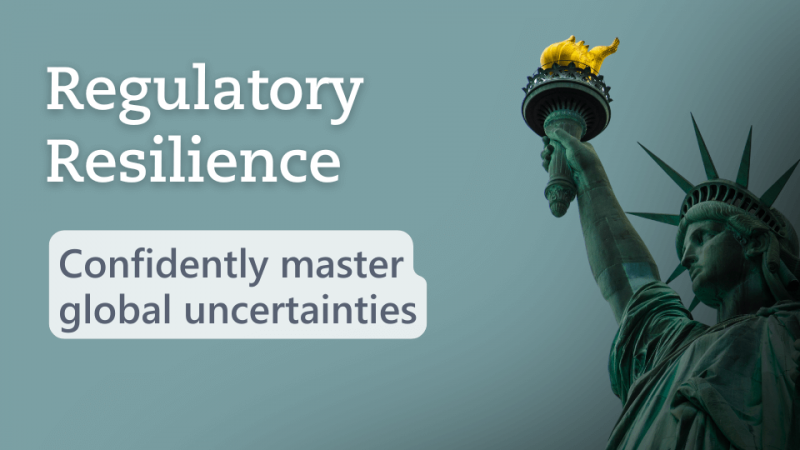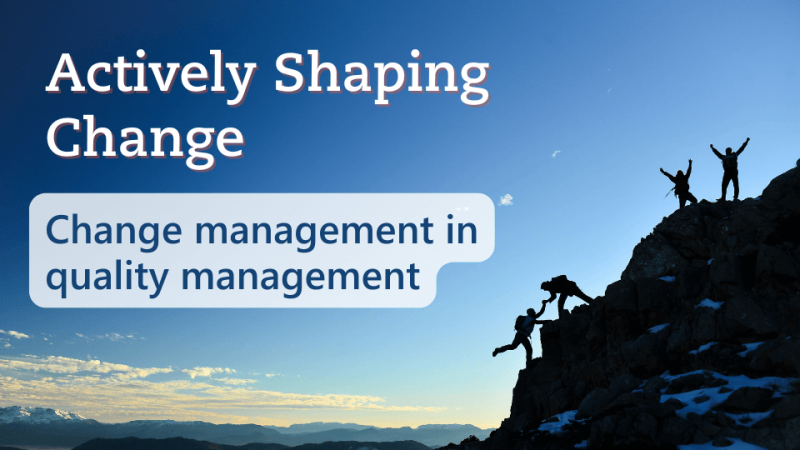Medical Laboratories: ISO 15189:2022 - What's new?
07/03/2023
Do you have any questions about the article or would you like to find out more about our services? We look forward to hearing from you!Make a non-binding enquiry now
The ISO 15189 standard was revised and published in December 2022 as international standard ISO 15189:2022. It is also available in the German version as DIN EN ISO 15189:2023: Medical laboratories - Requirements for quality and competence". The new ISO 15189:2022 is considered the basis for the accreditation of medical laboratories. What is new, what is different? The standard’s chapters have been restructured, the previous sections and the regulatory requirements described therein have been completely revised, and the requirements for quality and competence for point-of-care testing (POCT) are now also included.

The standard also focuses on risk management, which is aligned with the regulatory requirements of ISO 22367:2020 ("Medical laboratories − Application of risk management to medical laboratories"). Planning, implementing, and demonstrating the effectiveness of measures taken to mitigate potential risks are intended to reduce potential harm to patients, laboratory personnel and third parties.The topic of risk management is also essential for corrective and preventive actions (CAPA). The standard aims to increase the quality of the issued results, to ensure the validity of the test results and to avoid the issuance of incorrect test results. With chapter 8.5 of ISO 15189:2022, the topic of dealing with risks and opportunities is given its own chapter. In the predecessor standard, risk management was described only superficially under Chapter 4.11 "Preventive measures".The new version of ISO 15189:2022 also focuses on the competence of management and personnel. The experienced quality manager will recognize parallels with ISO 9001:2015, which is compared with ISO 15189:2022 in Appendix B. The revised standard requires that an accredited testing laboratory continuously and demonstrably address the requirements of its interested parties. In addition to patients and healthcare facilities, interested parties include the public, legislators, and other stakeholders that each testing laboratory must identify for itself.
Further information for healthcare personnel in dealing with POCT can be found in ISO/TS 22583 "Guidance for supervisors and operators of point-of-care testing (POCT) devices".Conclusion: For POCT users, the implementation of ISO 15189:2022 will apply in the future. The additional consideration of ISO 22870:2016 is no longer required, which can be seen as a relief. However, for users/manufacturers of in-house products ISO 15189:2022 will not be sufficient. For the manufacturing aspect, you need to consider ISO 13485:2016.
Do you have questions about the transition to the new ISO 15189:2022? Do you need support on your way to an accredited testing laboratory? Do you have questions about the regulatory requirements for your POCT? We are happy to support you! We are also at your side when it comes to your QMS. Contact us - together we will find the best solution for your needs.
Best Regards
Transition period
The transition period for converting accreditations from the old to the new version of the standard is set until December 5, 2025. Accredited medical laboratories must provide evidence of conversion to the revised standard by then. For this purpose, a conversion guide is expected from DAkkS.
Design of the quality management system according to the new ISO 15189:2022
The requirements for quality management system (QMS) processes in Annex C have also been significantly revised: The chapters of the revised standard are reorganized, subdivided into smaller parts, and some requirements for the QMS are significantly more detailed.Implementation of ISO 15189:2022’s requirements and subsequent accreditation of the testing laboratory are intended to ensure quality and competence in the medical laboratory. In the standard, the entire workflow is considered in the normative processes – from sampling to issuing the results and consulting the laboratory chain.The objective of the ISO 15189:2022’s revised edition is- to protect the safety and well-being of patients,
- to increase the quality and competence of testing laboratories, and
- to improve the comparability of accredited testing laboratories (that is using this standard or that are accredited according to it) or their test results.
The standard also focuses on risk management, which is aligned with the regulatory requirements of ISO 22367:2020 ("Medical laboratories − Application of risk management to medical laboratories"). Planning, implementing, and demonstrating the effectiveness of measures taken to mitigate potential risks are intended to reduce potential harm to patients, laboratory personnel and third parties.The topic of risk management is also essential for corrective and preventive actions (CAPA). The standard aims to increase the quality of the issued results, to ensure the validity of the test results and to avoid the issuance of incorrect test results. With chapter 8.5 of ISO 15189:2022, the topic of dealing with risks and opportunities is given its own chapter. In the predecessor standard, risk management was described only superficially under Chapter 4.11 "Preventive measures".The new version of ISO 15189:2022 also focuses on the competence of management and personnel. The experienced quality manager will recognize parallels with ISO 9001:2015, which is compared with ISO 15189:2022 in Appendix B. The revised standard requires that an accredited testing laboratory continuously and demonstrably address the requirements of its interested parties. In addition to patients and healthcare facilities, interested parties include the public, legislators, and other stakeholders that each testing laboratory must identify for itself.
Point-of-care testing (POCT)
For the approval of POCT, as well as for tests for self-testing, special IVDR regulations (Regulation (EU) 2017/746) must be observed. These include training requirements for users or product-specific quality controls.Requirements for POCT’s quality and competence were previously specified in ISO 22870:2016 "Point-of-care testing (POCT) — Requirements for quality and competence" (German version DIN EN ISO 22870:2017). The ISO 22870:2016’s requirements are now reflected in ISO 15189:2022.During the transition period of three years, ISO 15189:2012 in conjunction with ISO 22870:2016 (Point-of-care testing (POCT) - Requirements for quality and competence) can continue to be used as the basis for accreditation of POCT. After the transition period, only the revised ISO 15189:2022 will apply to accreditations in the field of POCT. The requirements of ISO 22870:2016 have been integrated into the new standard version of ISO 15189:2022.POCT in ISO 15189 - Annex A
POCT are not products for self-testing, but they are for use outside a laboratory environment. They are usually performed near the patient or on the patient by a health care professional. The distinction from tests for self-testing is emphasized in ISO 15189:2022.A separate annex (A) is dedicated to POCTs, which contains supplementary requirements and highlights four aspects:- The requirements apply to medical laboratories. Tests for in-house use are excluded and use outside medical laboratories is regulated by ISO/TS 22583, among others.
- The management of the healthcare facility shall ensure that appropriate processes are implemented to monitor the accuracy and quality of POCT performed within the organization. Roles and responsibilities must be defined and clearly communicated.
- Laboratories performing POCT need a quality representative who explicitly takes responsibility for implementing the quality requirements for POCT.
- It must be ensured that the user, i. e. the personnel, is appropriately trained. These requirements from Annex A can also be found in Chapter 5 of ISO 22870:2016 and in the IVDR.
Further information for healthcare personnel in dealing with POCT can be found in ISO/TS 22583 "Guidance for supervisors and operators of point-of-care testing (POCT) devices".Conclusion: For POCT users, the implementation of ISO 15189:2022 will apply in the future. The additional consideration of ISO 22870:2016 is no longer required, which can be seen as a relief. However, for users/manufacturers of in-house products ISO 15189:2022 will not be sufficient. For the manufacturing aspect, you need to consider ISO 13485:2016.
Conclusion: Changeover to ISO 15189:2022 - The clock is ticking!
While the transition period for implementing the new ISO 15189:2022 is set for December 5, 2025, laboratory operators should already take the first steps now. To be on the safe side, we recommend implementing the regulatory requirement adaptations that apply to you as soon as possible.You can get started with these points:- Start with a GAP analysis to identify the changes in regulatory requirements that are relevant to you and plan the necessary adjustments to your QMS. We are happy to provide support in this regard.
- Identify your interested parties and document their expectations.
- Consolidate and plan your approach to risks and opportunities.
- Determine if competency criteria are established for each function (lab management and lab staff) and if they are also reviewed regularly.
- Keep track of your internal audit and management review timelines to assess the implementation of new regulatory requirements and your QMS’ effectiveness.
Do you have questions about the transition to the new ISO 15189:2022? Do you need support on your way to an accredited testing laboratory? Do you have questions about the regulatory requirements for your POCT? We are happy to support you! We are also at your side when it comes to your QMS. Contact us - together we will find the best solution for your needs.
Best Regards
Our blog posts are researched and created with the utmost care, but are only snapshots of the regulations, which are constantly changing. We do not guarantee that older content is still current or meaningful. If you are not sure whether the article you have read on this page still corresponds to the current state of regulation, please contact us: we will quickly place your topic in the current context.




